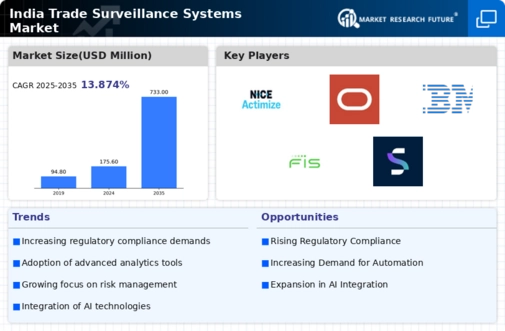The trade surveillance-systems market is currently characterized by a dynamic competitive landscape, driven by the increasing regulatory scrutiny and the need for enhanced compliance measures among financial institutions. Key players are actively pursuing strategies that emphasize innovation, partnerships, and regional expansion to maintain their competitive edge. Notably, companies such as Nasdaq (US), Thomson Reuters (CA), and Bloomberg (US) are at the forefront, leveraging their technological capabilities to offer advanced surveillance solutions that cater to the evolving demands of the market. Their collective focus on integrating artificial intelligence (AI) and machine learning (ML) into their systems appears to be shaping the competitive environment, as these technologies enhance the efficiency and accuracy of trade monitoring processes.
In terms of business tactics, companies are increasingly localizing their operations to better serve the Indian market, optimizing supply chains to reduce costs and improve service delivery. The market structure is moderately fragmented, with several players vying for market share, yet the influence of major companies remains substantial. This competitive structure fosters an environment where innovation is paramount, as firms strive to differentiate their offerings in a crowded marketplace.
In October 2025, Nasdaq (US) announced a strategic partnership with a leading Indian fintech firm to enhance its trade surveillance capabilities tailored for local regulations. This collaboration is expected to bolster Nasdaq's presence in the region, allowing it to leverage local expertise while providing customized solutions that meet the specific needs of Indian financial institutions. Such partnerships are indicative of a broader trend where global players seek to integrate more deeply into local markets.
In September 2025, Thomson Reuters (CA) launched a new AI-driven analytics tool designed to improve the detection of market manipulation and insider trading. This tool is particularly significant as it aligns with the increasing regulatory demands for transparency and accountability in trading practices. By enhancing its product offerings, Thomson Reuters positions itself as a leader in compliance solutions, potentially attracting a wider client base in India.
In August 2025, Bloomberg (US) expanded its trade surveillance platform to include advanced risk assessment features, which are crucial for financial institutions aiming to mitigate compliance risks. This expansion not only reflects Bloomberg's commitment to innovation but also highlights the growing importance of comprehensive risk management solutions in the trade surveillance landscape. Such developments suggest that companies are not merely competing on price but are increasingly focused on delivering value through technological advancements.
As of November 2025, the competitive trends in the trade surveillance-systems market are heavily influenced by digitalization, sustainability, and the integration of AI technologies. Strategic alliances are becoming more prevalent, as companies recognize the need to collaborate to enhance their technological capabilities and market reach. Looking ahead, it is likely that competitive differentiation will evolve, with a shift from traditional price-based competition towards a focus on innovation, technology, and the reliability of supply chains. This evolution underscores the necessity for firms to adapt and innovate continuously to remain relevant in an ever-changing market.
















Leave a Comment